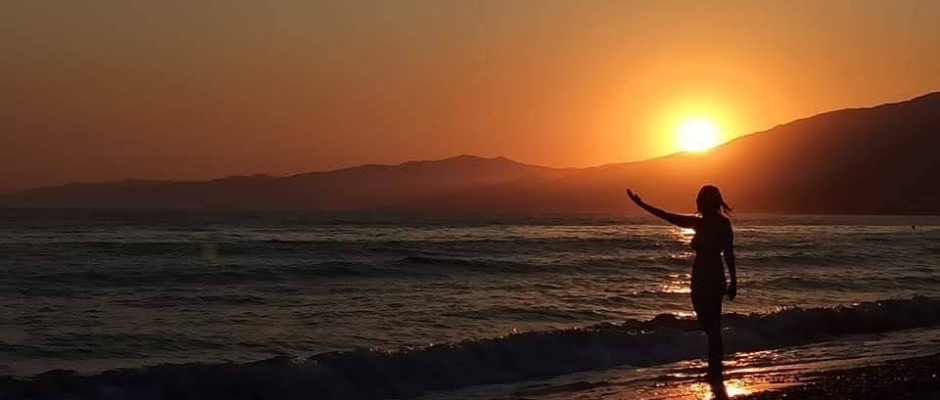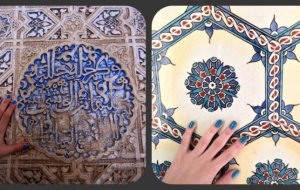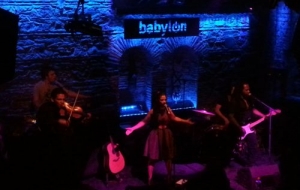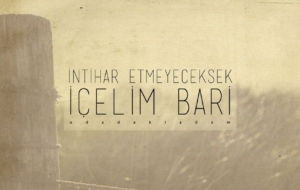This year we made another tour in west of Turkey (you can also have a look at our Turkish Riviera tour), so called Aegean Region from which my name also originates! We have a summer house in north Aegean close to the Mount Ida. We began our trip there.

Çeşme
Sooo, Çeşme is the famous summer district for many locals. Especially people from İzmir tend to have summerhouses here. As all Turks are floating here in summer, the prices are extremely high! We stayed in Çeşme center close to the Marina & Çeşme Castle.
Marina

Olivetree 
Giant Bonzai 

Castle in the background

The street of our hotel 
Grapes hanging from hotel’s terrace
So when I asked people around, I was recommended couple of beaches. The first thing you need to know is, almost every beach in Çeşme is private therefore has an entrance fee. These fees are between 100-250 TL per person which makes currently around €10-25. That’s quite a lot for Turkish conditions, I mean it is not the Amalfi Beach but still as many Istanbullers and many Germanturks are coming to the area, the prices are high. If you are on budget, you can still enjoy these shores however it will not be very comfortable. There are still some public beaches, partially very restricted and small and without shower & changing cabins. You have to bring your own umbrella & chairs or you can rent. I assume these private beaches made an agreement with Çeşme municipality not to build a shower and cabins in public beaches so that people will come to their beach and pay.
I was couple of times beaches around Aya Yorgi, this time I skipped this. We have been to Boyalık Beach, Ilıca Beach, Altınkum Bay and Cleopatra Bay.
Altınkum Beach
The water in Altınkum is colder than the other parts of Çeşme. It has a wonderful colour and very refreshing. There is a very small public beach where you can enjoy the sea for free. Or there are many private beaches arpımd if you would like to spend the whole day there!
Güvercinlik Bay (Cleopatra Bay)
This bay is a bit hard to find, and the road is not the perfect one. However as you see below the look is amazing. It was very crowded as we were there in high season, almost impossible to find a parking place! It resembles Kaputaş Beach a bit as you also need to go down to reach the beach and if you are carrying umbrella etc, it could be a bit tough. I would recommend you to go there early to guarantee yourself a parking place and enjoy the sea!
Ilıca Beach
Ilıca is a very large beach with a large public area. This time with showers and cabins! The name tells evreything but for non-Turkish-speakers, it refers to the warm water it has. And each place is perfectly separated with at least 1.5 meters, so the municipality really paid attantion to the Corona rules. The water was very clear in the morning even in the afternoon around 13-14.00. Afterwards, the colour starts to change a bit. Yes! The colour is very nice, almost like in the Maldives :P

Alaçatı
The famous Alaçatı! Alaçatı is a place full with old Greek stone houses with many restaurants, cafes, galleries. It is VERY crowded in August and if you have not booked before it is almost impossible to find places in restaurants.
Reyhan Patisserie
Reyhan is a very famous patisserie in İzmir that was founded in 1965. They have a branch in Çeşme so I wanted to use this chance to enjoy their desserts again!

Rokoko 
Polovak
We had a chance to grill at my father’s childhood friend’s summer house! It was located in Alaçatı but also close to “Ilıca”.
House of the Virgin Mary
I guess it was my second or third time in “House of the Virgin Mary”. It is a Catholic shrine located on Mount Koressos (Bülbüldağı), 7 km to Selçuk. The house was discovered in the 19th century.
While the Catholic Church has never pronounced in favour or against the authenticity of the house, the site has nevertheless received a steady flow of pilgrimage since its discovery.
Catholic pilgrims visit the house based on the belief that Mary, the mother of Jesus, was taken to this stone house by Saint John and lived there for the remainder of her earthly life. The shrine has merited several papal Apostolic Blessings and visits from several popes including Paul VI, John Paul II and Benedict XVI.
Ephesus Antique City
I have been to the Ephesus Antique city with my highschool back in 2003. So after almost 20 years, visiting the place again was wonderful! The world famous Celsus Library is here, even just to see that this visit is worth it!
The ancient city of Ephesus dates back to 1000 BC. The legendary founder of the city, Prince Androcles, found Ephesus with the prophecy of the oracle of the Temple of Apollo. Ephesus is the third largest Roman ruin in the world. The three most important monuments in Ephesus are the Temple of Artemis, the Library of Celsus and the Temple of Hadrian.
Antique Theater
Imagine giant antique theater… The piece was erected on the slope of Mount Pion and towering over the city at 30ish meters with a capactiy of 25.000 people! The Apostle Paul used it to preach the Gospel to Ephesians and condemn pagan worship.

Library of Celsus
The crowning glory of Ephesus is its famous library facade. It held 12.000 scrolls and held the most extensive Roman-Greek collection of cultural literature of that time. Known as the largest library after the Alexandria and Pergamon libraries during the Roman period,
It was built in 135 AD by emperor Gaius Julius Aquila who wanted to honour his father; who was a general Roman Empire governor for the province of Asia minor.
Hadrian Temple
The temple was constructed around 138 AD. It lies on the south side of Curates Street, one of Ephesus’ main arteries connecting the Gate of Hercules with the Library of Celsus. It was constructed by P. Quintilius to celebrate Hadrian visiting the city from Athens. Emperor Hadrian was considered one of the Five of Good Emperors. This term is used for the Roman emperors Nerva, Trajan, Hadrian, Antoninus Pius and Marcus Aurelius.



View from Hadrian Temple
Trajan’s Fountain
The Fountain of Trajan aka the Nymphaeum Traiani (Nymphaeum of Trajan), was built 102-114 AD. It had two ornamental pools. The original pool was 20 meters long and 10 meters wide. It has been recreated on a smaller scale.


Odeon
Used by the wealthy and political citizens to discuss the future of Ephesus
Relief of winged Nike 
Hercules Gate 
The Church of Mary (The Council Church)
The Council of Ephesus, aka Third Ecumenical Council, was a gathering of leaders of the Christian churches in the Roman Empire to deal with the Nestorian controversy. It was held over several sessions in 431 at the Church of Mary in Ephesus.
Ephesus Archaeological Museum
All the findings in the museum were brought from Saint John the Evangelist Church, Temple of Artemis, Belevi Mausoleum. I was really amazed by the Artemis statue here. So my mum got me a necklace of it from a local jewelry designer let’s say a birthday present! :)

Statue of Artemis 

Statue of Artemis I was amazed by it! 
İsa Bey Mosque
The mosque was built by the master Syrian architecture Ali son of Mushimish al -Damishki, between the years of 1374 and 1375. It is the oldest mosque to incorporate a large courtyard. Typical of its Selcuk – Turkish architecture are its two central domes, two lateral aisles, window mouldings, mosaics and painted Iznik tiles. It was originally used both as a place of worship and as a kervanserai. Here the Imam was English-speaking and wanted to communicate with my German husband. I felt pity for him because he was looking for people to pray with, and mentioned he had no audience!




Basilica Of Saint John
Saint John, one of the disciples of Jesus, came to Western Anatolia with Virgin Mary when Jesus died in 30s. It was thought that Saint John was buried around Ephesus after he died. During the Byzantine Empire, the famous emperor Justinian decided to build a church where Saint John’s tomb was located. (Not to forget, he also built Hagia Irene and Hagia Sophia in Istanbul). St. John’s Basilica was built between 548 and 565. Only ruins have survived from the church.


The tomb of St. John
Selçuk Ayasuluk Fortress
The first castle here was built in the Byzantine period however it changed hands after the Seljuk Empire entered Anatolia.The fortress had 15 watch towers, living spaces and mosques.
Şirince
Şirince is a cute little village with a fun history and beautiful views. It’s the perfect synthesis of a traditional Turkish village and traditional Greek village. Sirince Village was formed when people were fleeing Ephesus. They settled in the mountains and named the village Çirkince which translated into ugly. The reasoning for this was to keep outsiders from getting curious and coming into the village. The name was eventually changed to Sirince, which means pretty. Greeks settled in the village at one stage and this is clear in the styling of the houses. In 1924 there was an exchange of the Greek and Turkish population.
There are two churches in Şirince, one old Greek-hospital and a lodging building for the doctors. Currently this building is used as a boutique hotel and we stayed there. It was the perfect choice. I guess our hotel was the most instagrammed building in the village! :D Even my dad who does not call it a holiday when there is no sea really liked the village.


Our hotel: Doktorun Yeri 
The back entrance of the hotel 
The balcony of the hotel 
The Greek Hospital






Şirince is well-known for fresh produce, we enjoyed everythat we ate there. There are many local dishes prepared with herbs and vegetables.

Squash Blossoms 
Roasted herbs 
Atom (Yoghurt + Chili) 
Şevket-i Bostan
(Cnicus benedictus)
Saint Demetrius Church
An Orthodox church belonging to 18th century. It is up the steps to the right as you enter Şirince along the Selçuk road. It served as a mosque after 1923. It is now restorated and you can look at its frescoed vaulted ceiling and choir loft, iconostasis and marble floor


St John the Baptist Church
It is the other Orthodox church in Şirince dating back to 1905.
What about the drinks?

Şirince is famous with its fruit wines, you should make a tasting! 
You can also try the Turkish coffee heated up on hot sand
Pamukkale
Pamukkale is a UNESCO World Heritage Site and a famed destination since Roman times. Before reaching Pamukkale, we took a lunch break at Denizli city centre. There we ate the famous “tandır kebap / tandoor kebab”

Pamukkale Travertines & Thermal Pools
Pamukkale means “cotton castle” in Turkish and it is a natural site in Denizli. It is famous for a carbonate mineral left by the flowing of thermal spring water. So even back in 2nd century BC, it used to be a spa. Pamukkale’s terraces are made of travertine, a sedimentary rock deposited by mineral water from the hot springs. There are 17 hot springs with temperatures ranging from 35 °C (95 °F) to 100 °C (212 °F).




Hierapolis Antique Pool
The place had thousands of visitors in Roman times when it was still a health center. The mineral-rich waters from its hot springs were said to benefit people with skin diseases, circulation problems, rheumatism, heart diseases etc. The pool is surrounded by greenery and there are marble columns, capitals and plinths in it that are believed to have fallen from the nearby Temple of Apollo during an earthquake, making this a sacred pool. The Antique Pool was believed to be favored by Cleopatra, Queen of Egypt.



Hierapolis Antique City
Hierapolis means “sacred city”, ancients believed that Hierapolis was founded by the god Apollo. The site has the Tomb of Philip the Apostle.
Hierapolis Antique Theatre
The theatre is believed to have been built during the time of Emperor Hadrian, after the earthquake of 60 Ad. It is 92 meters long with 50 rows of seats that can accommodate around 15,000.


Hierapolis Archaeology Museum
The Roman bath of the Hierapolis antique city has been used as the site of the Hierapolis Archaeology Museum since 1984. In this museum has historical artifacts which were found in Hierapolis, Laodiceia, Colossae, Tripolis, Attuda.




Attis, 2. century AD 
Statue of Theatre Actor, 2 .century AD 
Priestess of Isis, 2. century AD

sarcophagi 

Relief of Gladiator Fights, 3. century AD 
Statue of Triton, 2. century AD
Küçükköy – Ayvalık
We visited a village close to Ayvalık which has been becoming popular in the recent years. It was called Yeniçarohori before referring to the Yeniçeri (janissary) soldiers in Ottoman Empire. Apparently after Ottomans conquering the Lesbos island in 1462, they located some of their soldiers in this village for potentials rebellions, that’s why the Greek-Ottomans called the village this way. Again with the population exchanges, some Bosnian-Turks started to live in the village. You can still see the wide range of Bosnian cuisine in all the cafes.
Şeytan Sofrası / Devil’s Feast- Ayvalık
This is a hill located 8 kilometers from the center of Ayvalik and was created by a lava pond left behind a dormant volcano. It has a very beautiful panoramic sunset view where you can see the Ayvalık islands and Lesbos island. According to the legend this hilltop has the footprint of the devil which is actually a geological feature created naturally thousands of years ago.

There is another legend explaining why the place is called “Devil’s Feast” apparently in 16th century under Ottoman Empire, a famine hit Ayvalık and everybody accused a girl called Penelope (nickanamed Devil) who was living an isolated life on this hilltop. As people decided to lynch her, she received the news and prepared a feast for people so that they could forget about her. While they were eating, she escaped.




















































